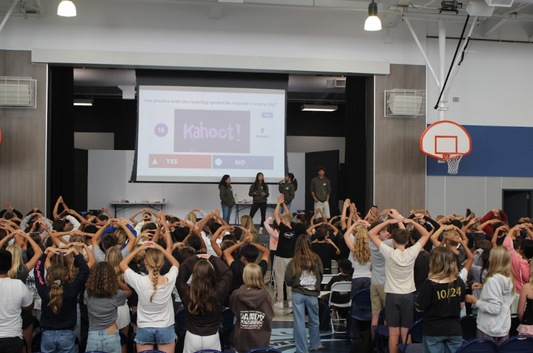With Halloween just passing and Thanksgiving steadily on its way, working towards sustainability may be the last thing on our minds. However, it is precisely at large scale, nation-wide holidays such as Halloween where waste levels skyrocket.
A survey conducted by The National Retail Federation predicted that total Halloween spending in 2025 was expected to reach a record $13.1 billion. This also means that millions of pounds of plastic candy wrappers will be sent to landfills. Despite candy wrappers being made from plastic, a mainly recyclable material, they are extremely hard to make work. Halloween candy wrappers are often covered in residue from the candy such as melted chocolate, peanut butter, and other oils. This results in a low quality plastic. Furthermore, the colorful, cheery wrappers that these candies have usually melt into a dull brown. Having low quality, brown plastic sharply limits the usability of the material. While the most efficient method to all waste is always to cut it off at the source, some remedies can include ordering a candy wrapper recycling box (Rubicon Technologies), upcycling your wrappers before they hit the waste bin, or contacting local recycling companies that may offer candy wrapper recycling initiatives.
Additionally, most costumes used for Halloween, which are often made of plastic and polyester, are bought with the intention of wearing them once and never again. A survey performed by UK based nonprofit Hubbub found that 83% of the material in 324 clothing items promoted through online platforms of retailers was oil-based plastic which is equal to 83 million Coca Cola bottles. However, these staggering numbers could be prevented by DIYing your costume or even buying your costume second hand. Once done, your costume can easily be dropped off at a local thrift store for collection.
Another large contributor to the Halloween waste party is pumpkins. After these pumpkins are no longer being used as decorations, around 1 billion pounds of pumpkins are discarded, creating approximately 18,000 tons of organic waste. This waste goes to landfills, rotting and releasing methane into our atmosphere. However, this waste can be easily reduced through using every part of the pumpkin you can, like roasting the seeds or using the flesh for soups before composting the remnants.
With the giant amount of plastic wrappers, single use costumes, and organic waste seen all over the world, Halloween steadily finds itself as one of the most wasteful holidays. While being more conscious about what you buy at the consumer level is most important, there are still choices you can make after the holiday has passed to minimize your damage on our planet.
Works Cited
Beegs. “Halloween Candy Wrappers Are Hard to Recycle!” RecycleNation, 10 November 2022, https://recyclenation.com/2022/11/halloween-candy-wrappers-are-hard-to-recycle/. Accessed 2 November 2025.
“NRF Consumer Survey Finds Halloween Spending to Reach Record $13.1 Billion.” National Retail Federation, 18 September 2025, https://nrf.com/media-center/press-releases/nrf-consumer-survey-finds-halloween-spending-to-reach-record-13-1-billion. Accessed 2 November 2025.
Rose, Chris. “Halloween Clothing & Costumes Survey 2019.” The Fairyland Trust, October 2019, https://www.fairylandtrust.org/wp-content/uploads/2019/10/Halloween-Plastics-Clothing-and-Costumes-Report-2019.pdf. Accessed 2 November 2025.
“Trick ‘R Treat the Planet Right: A Green Halloween Guide.” EcoBlvd, 25 October 2024, https://www.ecoblvd.com/blogs/news/everything-you-need-for-a-sustainable-halloween-2024?srsltid=AfmBOoqKc3xzwMkkYFz5A3I5t9pnr5pYZ_dWTI7oeZpQQpbC3RZ-lomo. Accessed 2 November 2025.




